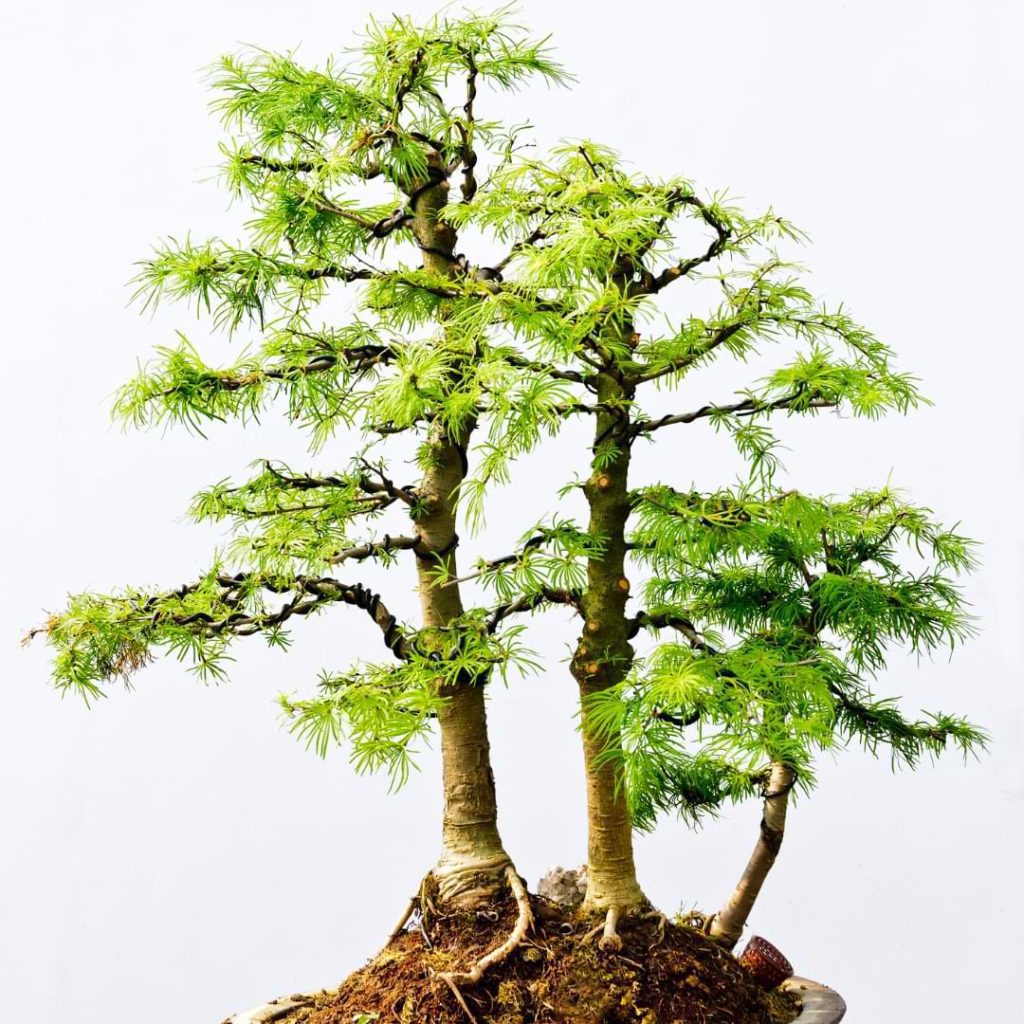Rocky Mountain pine bonsai is a hardy, slow-growing pine, which is part of why it’s a popular choice for bonsai. This species can tolerate drought as well as extreme weather conditions.
Although as a group pine species are more challenging bonsai, they are very popular among bonsai enthusiasts. However, they aren’t the best choice for beginners.
How to Grow Pine Bonsai
Growing pine bonsai is not the difficult part of having pine bonsai. While the care is not too difficult, the shaping and training is more difficult to handle.
In this article, we’ll talk about how to start your own pine bonsai as well as how to care for the bonsai trees once they are mature.
Growing Rocky Mountain Pine From Seeds
Growing pine trees from seeds is a relatively straightforward process. While it’s possible to grow Rocky Mountain pine from seed, be aware that this species grows very slowly. If you start this species from seed, it will be a long time before the tree is mature enough to bonsai.
Start your Rocky Mountain pine seeds indoors. Place each seed into its own pot filled with well-draining potting soil. Position each seed just below the soil surface, making sure the pointy end is facing down. Keep watering regularly and place it in a sunny window. The seeds need to remain moist in order to germinate, and it can take several months before this happens.
Once your seedlings are between 6 to 12 inches tall, you can bring them outdoors to continue growing.
Propagating Bonsai Pine From a Branch
Generally, growing plants from cuttings is one of the easiest ways to propagate. However, pine cuttings are a bit more finicky about rooting. If you have access to pine trees, it’s worth giving this a try anyway. Again, even when starting from a cutting, Rocky Mountain pine will take a long time to grow enough to bonsai.
It’s best to take cuttings from pine trees during fall or winter, and the cuttings should be between 4 to 6 inches long from healthy branches. Take multiple cuttings because not all the cuttings will root.
Remove the needles from the bottom half of the cuttings and dip the bottom of each cutting in rooting hormone. Place the cut part of the branch in an individual container filled with well-draining soil that is moist but not soaking wet.
Cover the containers with a clear plastic bag to keep moisture from escaping. Continue watering as the soil dries out. Keep cuttings in bright, indirect light, and remove the plastic once you see new growth happening.
Be aware that the cuttings may take up to 12 months to root. Once the plant is established, you can move it outdoors to continue growing.
Rocky Mountain Pine Growth Rate
Rocky Mountain pine is naturally a medium-size tree, but because of its very slow growth rate, it’s easier to keep this species the right size for bonsai. However, this also means that starting Rocky Mountain pine from seed or from cuttings can take a long time.
Expect to see growth of about 3 to 6 inches each year with Rocky Mountain pine.
Growing Indoor or Outdoor
Rocky Mountain pine bonsai should only be grown outdoors as these trees do not do well when grown indoors. However, you will need a spot outdoors to shelter your pine bonsai during the winter if temperatures drop below freezing. While Rocky Mountain pines are hardy, they are a little more vulnerable when grown as bonsai.
Pruning, Wiring, & Shaping Pine Bonsai
Even though pine bonsai is very popular, it’s not an easy species to bonsai. Pine bonsai are difficult to prune because they need to be shaped slowly to avoid harming or stunting the pine.
Prune while the pine bonsai is dormant, and don’t prune more than half of a pine’s growth during one year. Pine bonsai do not bounce back well from severe pruning. If you’ve repotted your bonsai, it may be harder for the tree to recover from extensive pruning. The shaping process for pine bonsai happens slowly, so you’ll need patience.
Wire pine bonsai during the fall or winter while growth is slowed and there’s less risk of damage. Make sure to remove the wire as branches begin to grow larger to avoid scarring the branches.
As you can see, training pine bonsai requires patience as well as a good technique, which is why pine bonsai is not the best bonsai for beginners. However, as you gain more bonsai experience, it’s very rewarding to grow this tree as bonsai.
Rocky Mountain Bristlecone Pine Bonsai Tree Care
While training Rocky Mountain pine bonsai is finicky, actually caring for Rocky Mountain pine is much easier. Thanks to its hardy nature, you shouldn’t have too much trouble providing the right conditions for a healthy, mature Rocky Mountain pine bonsai.
Light
During the spring, summer, and fall, pine trees need a lot of light. Place Rocky Mountain pine bonsai in the sunniest location available, preferably somewhere with full sun. The tree needles actually grow longer when pines don’t get enough sunlight, so more sun will keep your bonsai more proportional.
Temperature and Humidity
Pine bonsai cannot be grown indoors because the temperature is too different from its native environment. Rocky Mountain pine bonsai can handle the heat during the summer, and while they are frost-tolerant, it’s best to shelter them from severe winter weather; being planted in a pot rather than in the ground makes this hardy mountain pine more vulnerable to freezing temperatures than it would be otherwise.
Soil
For best results, pine bonsai need well-draining potting soil. Generally, commercial bonsai soil works well. Pines do prefer slightly acidic soil with a pH between 5.5 and 6.5, but most commercial soil mixes for bonsai fall within this range anyway.
Water
While Rocky Mountain pine bonsai require consistent moisture, they also don’t want to sit in water. This is why well-draining soil is important. Plan to water your bonsai when the top 1 to 2 inches of the soil has dried out. You’ll need to water more often as the weather gets hotter.
Fertilizing
Rocky Mountain pine naturally survives in an environment with poor-quality soil, though you will see some benefit from light applications of fertilizer for Rocky Mountain pine bonsai. During the growing season, apply a balanced fertilizer to your bonsai each week. Start at half the recommended strength at first; you can always add more later if needed, but this hardy pine species probably won’t need the additional fertilizer.
Potting and Repotting
While some bonsai need frequent repotting, pine bonsai don’t need repotting quite this often. Depending on the maturity of your Rocky Mountain pine bonsai, you only need to repot every 2 to 5 years. Older bonsai plants need to be repotted less often than young bonsai.
Repotting is necessary from time to time, both to refresh the soil and to prevent the bonsai from becoming root-bound. When repotting, you can trim up to ⅓ of the root ball.
You won’t always need to select a larger container for your bonsai, but when it comes time to move to a new container, make sure the new pot has adequate drainage.
Common Pests/Diseases
Pine bonsai can fall prey to several common pests and diseases. The most common disease that affects Rocky Mountain pine trees is root rot, which usually occurs as a result of overwatering or a lack of good drainage.
The pests that affect pine bonsai are common ones like aphids, spider mites, and scales. These pests can be treated before they do too much damage to your Rocky Mountain pine bonsai.
Other Varieties of Pine to Bonsai
With more than 120 species, trees in the genus Pinus have many different attributes. The majority of species within this genus are able to be bonsai, however, some species are more popular as bonsai than others.
Here are a few notable varieties you might be interested in.
Pinus mugo (Mountain pine)
This variety is particularly hardy and is unbothered by bad weather or extreme changes in temperature. Mountain pine also has beautiful purple flowers.
Pinus parviflora (Japanese white pine)
This variety is sought after by bonsai lovers because of its unique white foliage.
Pinus sylvestris (Scot pine)
This variety is one of the easier pine species to bonsai. Japanese white pine is fairly easy to shape and doesn’t lose its foliage as readily when stressed.
Pinus thunbergii (Japanese black pine)
This variety is a classic bonsai species. Bonsai enthusiasts who want to honor the origins of bonsai typically prize this pine. However, it’s not an easy pine species to keep as bonsai.
Rocky Mountain Pine Bonsai FAQ
FAQ: Is Rocky Mountain pine bonsai toxic to cats or dogs?
Pine tree needles and sap can be mildly toxic to cats, so it’s best to keep cats who are tempted to play with plants away from your bonsai. Pine trees can also cause dogs to throw up if ingested. But since pine bonsai should be kept outdoors, they don’t pose a risk to most cats or dogs.
Bonsai With Us!
The Bonsai Resource Center is here to help you learn about all things bonsai and provide you with the tools you need to keep your plant healthy and strong. Explore our other articles, visit our online shop, and connect with other bonsai lovers in our Facebook group to learn everything you need to know about this rewarding hobby!



